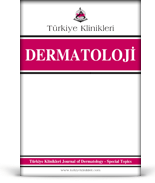Objective: As with every chronic disease, YouTube is increasingly heavily accessed to get information for psoriasis. It contains quality videos containing medical information; however, some content is of low quality, unscientific, misleading, and potentially harmful. We aimed to conduct this study to reveal this situation, understand the rate of non-physician practice, and develop solutions. Material and Methods: Between May 1-31, 2022, we searched the YouTube search engine by typing 'psoriasis treatment' in Turkish. The number of views of the video, the number of subscribers, time of publication, duration of the video, gender and occupation of the presenter, type of YouTube channel on which the video was posted, were recorded. In the analysis of analytical statistics, the Quade test was used to eliminate the severity of the difference in the number of views and the extreme difference of skewness. Levene's test was used for homogeneity analysis. Results: The majority of the videos consisted of education-information about psoriasis treatment methods (41.6%) and specific treatment recommendations (35%). 46.2% of the video narrators were physicians (21.7% dermatologist, 24.5% non-dermatologist) 25.8% were non-physicians, and herbalists (15.4%) were the leading ones. The rate of evidence-based treatment recommendations was 24.5%, while the rate of non-evidence-based treatments was 65.7%. Conclusion: We have identified videos created by herbalists who recommend supplements containing plant extracts, which are not based on substantial evidence. There should be more videos on YouTube about psoriasis and its treatment by dermatologists who are experts in the subject.
Keywords: Psoriasis treatment; YouTube; social media; non-physician practice
Amaç: Her kronik hastalıkta olduğu gibi sedef hastalığı hakkında bilgi almak için YouTube'da giderek daha fazla bilgiye erişilmektedir. Bu platform, tıbbi bilgiler içeren kaliteli videolar içerir; ancak bazı içerikler düşük kaliteli, bilimsel olmayan, yanıltıcı ve potansiyel olarak zararlıdır. Bu durumu ortaya çıkarmak, doktor dışı uygulama oranını anlamak ve çözümler geliştirmek için bu çalışmayı yapmayı amaçladık. Gereç ve Yöntemler: 1-31 Mayıs 2022 tarihleri arasında YouTube'daki arama motoruna Türkçe dilinde ''sedef hastalığı tedavisi'' yazarak aratma yaptık. Video görüntüleme sayısı, abone sayısı, yayınlandığı zaman, videonun süresi, sunum yapan kişinin cinsiyeti ve mesleği, videonun yayınlandığı YouTube kanalı türü kaydedildi. Çözümsel istatistiklerin analizinde görüntüleme sayılarının farkının şiddeti ve çarpıklığın aşırı farkını elimine etme amacıyla Quade testinden yararlanıldı. Homojenite incelemesinde Levene testi kullanıldı ve enter metotlu doğrusal regresyon kullanılarak %95 güven düzeyinde bulgular değerlendirildi. Bulgular: İncelenen videoların büyük çoğunluğu psöriyazis tedavi yöntemleri ile ilgili eğitim-bilgilendirme (%41,6) ve spesifik tedavi önerilerinden (%35) oluşmaktaydı. Konuşmacıların %46,2'si hekimdi (%21,7 dermatolog, %24,5 dermatolog haricî hekim) %25,8'i ise hekim dışı kişilerden oluşmaktaydı ve bunların başında herbalistler gelmekteydi (%15,4). Kanıta dayalı tedavi önerilerinin oranı %24,5 iken, kanıta dayalı olmayan tedaviler %65,7 oranındaydı. Sonuç: Azımsanmayacak derecede kanıta dayalı olmayan ve internet üzerinden satın alınabilecek bitki ekstresi içeren gıda takviyelerini, tedavi olarak öneren bitkilerle tedavi uzmanı kişilerce oluşturulmuş videolar tespit ettik. Sedef hastalığı ve tedavisi ile ilgili konunun uzmanı olan dermatologlar tarafından YouTube'da daha fazla video olmalıdır.
Anahtar Kelimeler: Sedef hastalığı tedavisi; YouTube; sosyal medya; hekim dışı pratik
- Lenczowski E, Dahiya M. Psoriasis and the digital landscape: YouTube as an information source for patients and medical professionals. J Clin Aesthet Dermatol. 2018;11(3):36-8. [PubMed] [PMC]
- Mueller SM, Jungo P, Cajacob L, Schwegler S, Itin P, Brandt O. The absence of evidence is evidence of non-sense: cross-sectional study on the quality of psoriasis-related videos on YouTube and their reception by health seekers. J Med Internet Res. 2019;21(1):e11935. [Crossref] [PubMed] [PMC]
- Hongler VNS, Navarini A, Brandt O, Goldust M, Mueller SM. Global trends in YouTube and google search activity for psoriasis and atopic eczema: detecting geographic hot spots, blind spots and treatment strategies. Dermatol Ther. 2020;33(4):e13510. [Crossref] [PubMed]
- Reuter K, Lee D. Perspectives toward seeking treatment among patients with psoriasis: protocol for a twitter content analysis. JMIR Res Protoc. 2021;10(2):e13731. [Crossref] [PubMed] [PMC]
- Aslan Kayıran M, Karadağ AS, Oğuz Topal İ, Adışen E, Kılıç S, Keskin N, et al. Habits of using social media and the internet in psoriasis patients. Dermatol Pract Concept. 2022;12(3):e2022143. [Crossref] [PubMed] [PMC]
- Kemp S. YouTube reach rate. 2022, July 2022. [Link]
- Gorrepati PL, Smith GP. Evaluating social media as a source of patient information regarding psoriasis treatments using the DISCERN instrument. J Dermatolog Treat. 2022;33(5):2685-6. [Crossref] [PubMed]
- Qi J, Trang T, Doong J, Kang S, Chien AL. Misinformation is prevalent in psoriasis-related YouTube videos. Dermatol Online J. 2016;22(11):13030/qt7qc9z2m5. [Crossref] [PubMed]
- Iglesias-Puzas Á, Conde-Taboada A, Aranegui-Arteaga B, López-Bran E. "Fake news" in dermatology. Results from an observational, cross-sectional study. Int J Dermatol. 2021;60(3):358-62. [Crossref] [PubMed]
- Reynolds KA, Pithadia DJ, Lee EB, Wu JJ. A cross-sectional study of YouTube videos about psoriasis biologics. Int J Dermatol. 2019;58(3):e61-e2. [Crossref] [PubMed]
- Pithadia DJ, Reynolds KA, Lee EB, Wu JJ. A cross-sectional study of YouTube videos as a source of patient information about topical psoriasis therapies. J Dermatolog Treat. 2020;31(4):366-9. [Crossref] [PubMed]
- Menzies S, Daly S, McKenna DB. Social media and psoriasis treatment: what are people saying on Twitter? Br J Dermatol. 2019;180(6):1527-8. [Crossref] [PubMed]
- Pithadia DJ, Reynolds KA, Lee EB, Wu JJ. A cross-sectional study of YouTube videos as a source of patient information about phototherapy and excimer laser for psoriasis. J Dermatolog Treat. 2020;31(7):707-10. [Crossref] [PubMed]
- Haslam K, Doucette H, Hachey S, MacCallum T, Zwicker D, Smith-Brilliant M, et al. YouTube videos as health decision aids for the public: An integrative review. Can J Dent Hyg. 2019;53(1):53-66. [PubMed] [PMC]
- RTUK. Türkiye'de televizyon izleme alışkanlıkları. 2018. 07.07.2018. [Link]
- Kuru T, Erken HY. Evaluation of the quality and reliability of YouTube videos on rotator cuff tears. Cureus. 2020;12(2):e6852. [Crossref] [PubMed] [PMC]
- Madathil KC, Rivera-Rodriguez AJ, Greenstein JS, Gramopadhye AK. Healthcare information on YouTube: A systematic review. Health Informatics J. 2015;21(3):173-94. [Crossref] [PubMed]







.: Process List